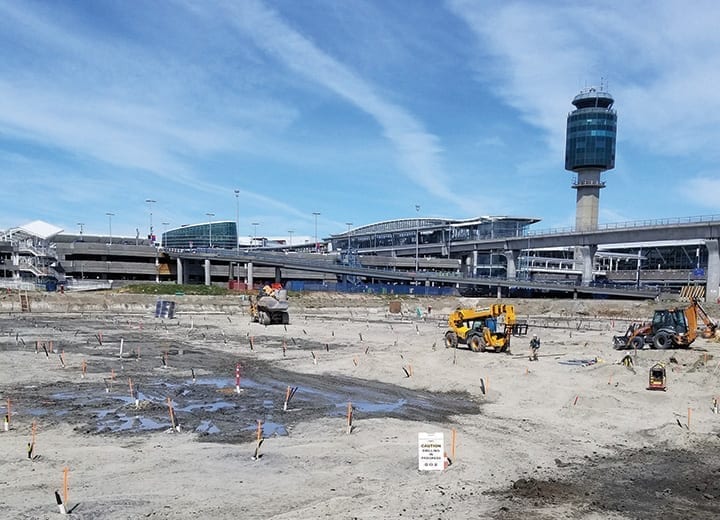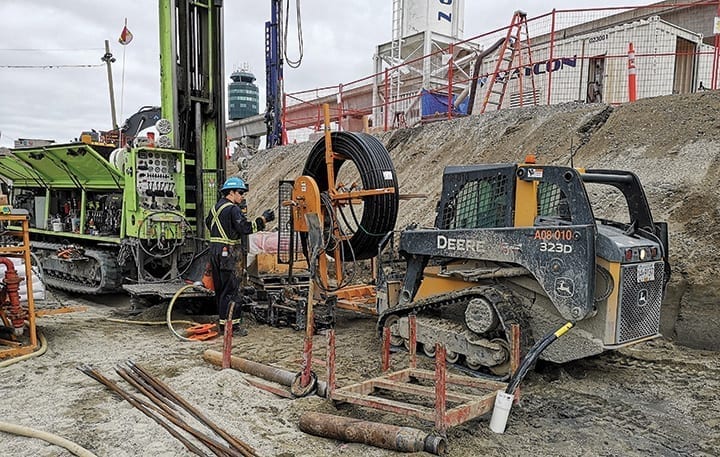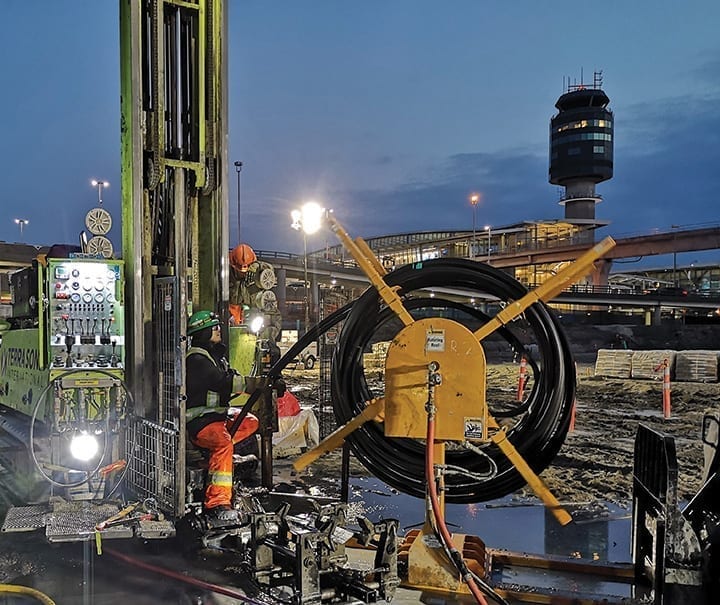Geothermal Project Powers Airport Expansion
Vancouver International Airport is the largest facility in British Columbia and requires a lot of heating and cooling. Those needs will be increased by a $300 million expansion designed to add 300,000 square feet to the terminal complex’s already spacious environs.
The airport is in the midst of a number of capital construction projects, part of the facility’s multi-year expansion that will see the airport complete 75 major projects, totaling $9.1 billion over 20 years. To help meet the power demands of the expansion, and to also substantially limit its environmental footprint, the airport chose an eco-friendly geoexchange, or ground source geothermal, system for heating and cooling. The new Central Utilities Building, still under construction, will improve efficiency by centralizing all the equipment needed to meet the airport’s heating, cooling, and electricity demands.
The airport’s geothermal exchange system project was recently honored by the Plastics Pipe Institute Inc. (PPI). PPI is the major North American trade association representing all segments of the plastic pipe industry. Canadian pipe manufacturer Versaprofiles, the Quebec-based company that provided the pipe for the airport’s geothermal exchange system, received Project of the Year for Building & Construction at PPI’s virtual annual meeting in May.
 |
|
1. The Vancouver airport’s system required hundreds of vertical boreholes to provide sustainable heating and cooling for the terminal. It is one of the largest geothermal energy projects in Canada. Courtesy: Plastics Pipe Institute (PPI) |
The geothermal system’s design required hundreds of vertical boreholes (Figure 1) to provide sustainable heating and cooling for the terminal and is one of the largest geothermal energy projects in Canadian history. Borehole drilling and installation of the geothermal loops and headers is complete, and the 67,000-square-foot Central Utilities Building is expected to be operational by 2022.
This $350 million system is crucial to the airport’s objective to reduce greenhouse gas emissions. It is expected to substantially reduce CO2 emissions from heating and cooling by 30% to 35%.
Heat pump-based geoexchange systems can significantly flatten the electricity grid’s energy demand curve. They also reduce dependence on fossil fuels for heating and cooling, and are becoming a leading technology in the electrification of government and commercial building infrastructure.
“PPI and our members promote the adoption of geothermal technologies to help reduce energy consumption for heating and cooling buildings, saving owners money,” said Lance MacNevin, PE, director of engineering for PPI’s Building & Construction division. “Other benefits of ground source systems are better reliability and building resiliency, with no exposed outdoor components. Also, water-to-water heat pumps are a perfect match for hydronic heating and cooling distribution systems, which are comfortable and efficient technologies for use in residential and high-performance commercial construction.”
MacNevin’s group has established a Geothermal Steering Committee to focus support specifically on the geothermal industry.
HDPE Piping Loops
Versaprofiles in 2019 signed an agreement with Ground Source Energy, an Alberta-based geothermal contractor, to manufacture and supply the high-density polyethylene (HDPE) geothermal piping loops for the project. One of the main challenges was to ship the geothermal piping loops almost 3,000 miles across Canada. Seventeen containers of pipes left the production facility, traveling first by truck, then by train to Vancouver.
Versaprofiles’ contribution to the project was 841 Verticaloop single U-bend geothermal loops, each 1,000 feet long with a molded and heat-fused U-bend installed at the midpoint, for a total of 841,000 feet of HDPE geothermal piping. The job used about 280,000 pounds of resin and required the equivalent of 35 days of production capacity for the company’s Saint-Lazare-de Bellechasse, Quebec, facility. The first geothermal loops were installed in April 2019.
Tony Mooney, project manager at Ground Source Energy, said one of the most important considerations of geothermal energy installations is ground conditions. “The lithology, or rock characteristics, needs to be of a high-enough thermal conductivity to move energy through the earth,” said Mooney. “In this case, the soft glacial till overburden provided wet soil conditions that are suitable for heat transfer to occur.
“The glacial till affects the thermal conductivity of the ground, which affects the size of the system they need to get the energy, and our drilling methodology,” Mooney said. “We still put the HDPE loop in the same way we do into bedrock or for any other application or system. How we make the hole and how many holes needed depends on how the earth varies. So, if it’s sand, you typically don’t even put geo where there’s sand, but if you’re in bedrock, heat moves well. If you’re in wet soil, the thermal conductivity moves well, wherever heat can transfer, and that determines how many holes you need. So, if it was more sandy and dry, it would be less conductive, and you’d need more holes and more loops to get the same amount of energy out of the ground.”
He continued: “The only problem with glacial till is that it isn’t bedrock,” he said, noting that means drilling with the casing in each hole to keep the hole from collapsing on itself. The pipe is then fed into the hole from a spool.
 |
|
2. The piping loop, after being placed in the ground, was surrounded with thermally enhanced grout. Courtesy: PPI |
“Because it’s glacial till, we used sonic drilling and drilled with the casing, because you can’t use air rotary or other methodologies because there is no bedrock to keep the hole open, so you have to have casing all the way down so the hole stays open, so you can put the loop in,” Mooney said. “We put the loop in within the casing and then we grout (Figure 2). We end up with a loop in the ground surrounded with thermally enhanced grout, and just normal earth.”
“The piping material is critical to the overall success of geothermal systems,” said David Fink, president of PPI, adding that it “must provide corrosion and chemical resistance, flexibility, long-term toughness [impact resistance], pressure capability, and temperature resistance. HDPE pipe is often specified for this type of project because of its proven durability. Those attributes were called on for this extreme endeavor and it was a pleasure to honor it with the PPI Project of the Year award.”
How the System Works
Vertical piping loops are connected to larger diameter headers that run horizontally through the pipe field. Heat exchange fluid enters the HDPE pipe at one end of the vertical loop, travels to the bottom of the pipe where there is a U-bend, then heads back up to the surface. Within this closed-loop system, heat is exchanged with the earth, and no fluid leaves the system. The pipe loop, or ground-coupled heat exchanger, is the thermal energy source during heating cycles and the thermal sink during cooling cycles.
Geothermal fluid transfers from the borefield to the central energy plant, which exchanges heat with a district energy system that will ring the terminal with a network of heavy-duty, 10- to 24-inch-diameter HDPE pipes. Mooney said at the Vancouver airport, because of the mild West Coast climate, most of the time heat will be drawn from airport buildings, extracted through heat pumps in the Central Utilities Building, and pumped into the ground. To heat buildings, thermal energy will be transferred back into the geothermal fluid as it travels through the borefield.
 |
|
3. Each of the boreholes at Vancouver International Airport contains 1,000 feet of 1.25-inch PE4710 high-density polyethylene (HDPE) pipe. Courtesy: PPI |
Each 500-foot borehole contains 1,000 feet of 1.25-inch PE4710 HDPE pipe (Figure 3). These pipes link to lateral headers that carry the fluid to the Central Utilities Building. The headers feed into manifolds that tie into heat pumps, which distribute the geothermal energy to and from airport buildings. Ground Source Energy used 16,800 feet of HDPE header pipes to complete the geoexchange system. “There’s pipe everywhere,” said Mooney.
According to PPI, PE4710 is the highest performance classification of HDPE piping material for fluid applications. PE4710 compounds offer a high level of performance with increased flow capacities plus increased resistance to surge pressure, fatigue, and slow crack growth.
“All the parties involved were grateful to have completed this large-scale commercial project ahead of schedule,” said MacNevin. “Drilling was a team effort, with three companies collaborating to achieve success. Given the high-profile nature of the Vancouver International Airport geothermal exchange system, the drilling firms were under 24/7 oversight by Ground Source Energy to ensure all boreholes were drilled to target depth and pipes were subjected to post-installation pressure testing to ensure integrity.”
He continued: “The expected performance of the Vancouver International Airport Central Utilities Building geoexchange system will certainly show how plastic pipe can be part of the sustainable solutions to save our planet. This has to be good news to all of us.”
—Steve Cooper is with the Plastics Pipe Institute (PPI), the major North American trade association representing all segments of the plastic pipe industry.